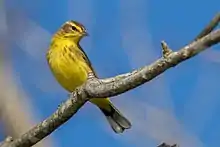Setophaga
Setophaga is a genus of birds of the New World warbler family Parulidae. It contains at least 33 species. The males in breeding plumage are often highly colorful. The Setophaga warblers are an example of adaptive radiation with the various species using different feeding techniques and often feeding in different parts of the same tree.
| Setophaga | |
|---|---|
 | |
| Blackburnian warbler, Setophaga fusca | |
| Scientific classification | |
| Domain: | Eukaryota |
| Kingdom: | Animalia |
| Phylum: | Chordata |
| Clade: | Dinosauria |
| Class: | Aves |
| Order: | Passeriformes |
| Family: | Parulidae |
| Genus: | Setophaga Swainson, 1827 |
| Type species | |
| Motacilla ruticilla[1] Linnaeus, 1758 | |
| Synonyms | |
|
Parula Bonaparte, 1838 | |

Most Setophaga species are long-range migrants, wintering in or near the New World tropics and seasonally migrating to breed in North America. In contrast, two Setophaga species, the palm warbler and yellow-rumped warbler, have winter ranges that extend along the Atlantic coast of North America as far north as Nova Scotia.[2]
Taxonomy
The genus Setophaga was introduced by the English naturalist William Swainson in 1827.[3] The type species was subsequently designated by Swainson in the same year as the American redstart Setophaga ruticilla.[4][5] The genus name is from Ancient Greek ses, "moth", and phagos, "eating".[6]
Traditionally, most members (29 species) of Setophaga were recognized as belonging to the genus Dendroica. The only member of Setophaga was the American redstart. More recent genetic research suggested that Dendroica and Setophaga be merged. This change was accepted by both the North American and South American Classification Committees of the American Ornithological Society[7][8] and the IOC World Bird List.[9] As the name Setophaga (published in 1827) takes priority over Dendroica (published in 1842), those who accept the merger transferred all Dendroica species to Setophaga.[10]
List of species
.jpg.webp)
- Adelaide's warbler, Setophaga adelaidae
- American redstart, Setophaga ruticilla
- American yellow warbler, Setophaga petechia
- Arrowhead warbler, Setophaga pharetra
- Bahama warbler, Setophaga flavescens
- Barbuda warbler, Setophaga subita
- Bay-breasted warbler, Setophaga castanea
- Blackburnian warbler, Setophaga fusca
- Blackpoll warbler, Setophaga striata
- Black-throated blue warbler, Setophaga caerulescens
- Black-throated green warbler, Setophaga virens
- Black-throated grey warbler, Setophaga nigrescens
- Cape May warbler, Setophaga tigrina
- Cerulean warbler, Setophaga cerulea
- Chestnut-sided warbler, Setophaga pensylvanica
- Elfin woods warbler, Setophaga angelae
- Golden-cheeked warbler, Setophaga chrysoparia
- Grace's warbler, Setophaga graciae
- Hermit warbler, Setophaga occidentalis
- Hooded warbler, Setophaga citrina
- Kirtland's warbler, Setophaga kirtlandii
- Magnolia warbler, Setophaga magnolia
- Northern parula, Setophaga americana
- Olive-capped warbler, Setophaga pityophila
- Palm warbler, Setophaga palmarum
- Pine warbler, Setophaga pinus
- Plumbeous warbler, Setophaga plumbea
- Prairie warbler, Setophaga discolor
- Saint Lucia warbler, Setophaga delicata
- Townsend's warbler, Setophaga townsendi
- Tropical parula, Setophaga pitiayumi
- Vitelline warbler, Setophaga vitellina
- Myrtle warbler, Setophaga coronata
- Audubon's warbler, Setophaga auduboni
- Black-fronted warbler, Setophaga auduboni nigrifrons
- Goldman's warbler, Setophaga goldmani
- Yellow-throated warbler, Setophaga dominica
- Yellow-rumped warbler, Setophaga coronata
References
- "Parulidae". aviansystematics.org. The Trust for Avian Systematics. Retrieved 2023-07-16.
- "Explore BNA". Cornell Lab of Ornithology. Retrieved 2017-03-01.
- Swainson, William John (1827). "A synopsis of the birds discovered in Mexico by W. Bullock, F.L.S. and Mr. William Bullock jun". Philosophical Magazine. New Series. 1: 364–369 [368]. doi:10.1080/14786442708674330.
- Swainson, William John (1827). "On several groups and forms in ornithology, not hitherto defined". Zoological Journal. 3: 343–363 [360].
- Paynter, Raymond A. Jr, ed. (1968). Check-list of Birds of the World. Vol. 14. Cambridge, Massachusetts: Museum of Comparative Zoology. p. 33.
- Jobling, James A. (2010). The Helm Dictionary of Scientific Bird Names. London, United Kingdom: Christopher Helm. p. 355. ISBN 978-1-4081-2501-4.
- Chesser R. T.; et al. (2011). "Fifty-Second Supplement to the American Ornithologists' Union Check-list of North American Birds" (PDF). Auk. 128 (3): 600–613. doi:10.1525/auk.2011.128.3.600. S2CID 13691956.
- A Classification of the Bird Species of South America, accessed 17 August 2016
- IOC World Bird List New World warblers & oropendolas
- Lovette, Irby J.; et al. (2010). "A comprehensive multilocus phylogeny for the wood-warblers and a revised classification of the Parulidae (Aves)" (PDF). Molecular Phylogenetics and Evolution. 57 (2): 753–70. doi:10.1016/j.ympev.2010.07.018. PMID 20696258.